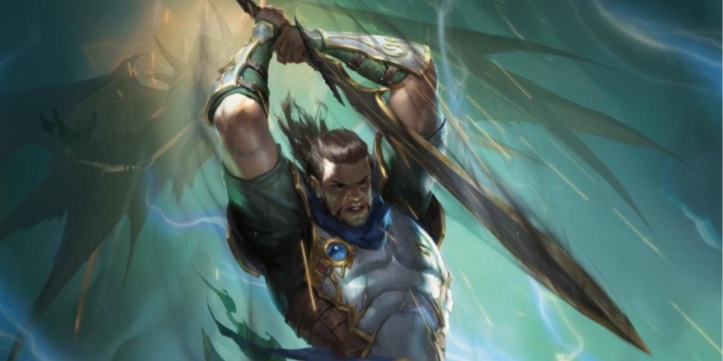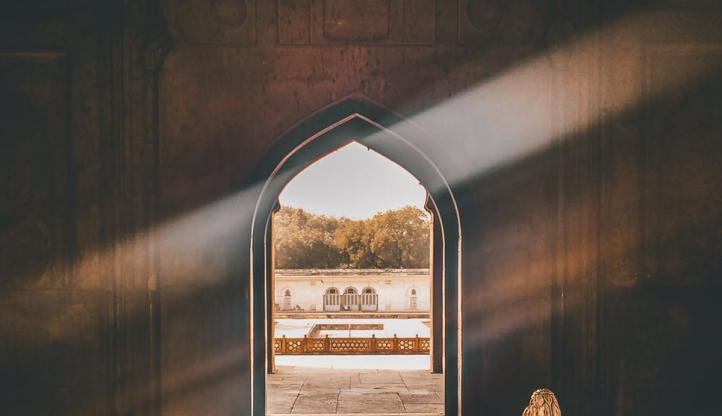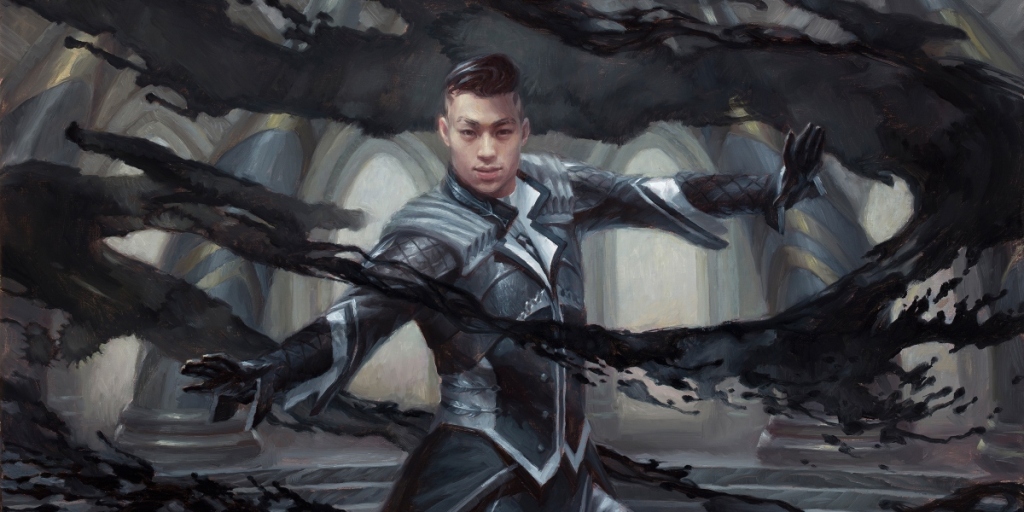At Artificial Twenty, I’ve not made much secret of liking Dungeons & Dragons gish builds. Even though, when dice come to table, I tend to roll martial more than anything else, gishes are some of the best builds in D&D 5e.
Gishes combine martial and magic in any number of ways. Whether they change between melee and magic as they fight, buff themselves before eviscerating foes, or blast their enemies and mop up with a sword, they make for some of D&D 5e‘s best combat classes.
However you build your gish in D&D 5e, they need more than just a weapon and a subclass. Spell selection is a huge part of playing one. Without top-tier combat spells, you’re not much more than a warrior who can use utility magic (which is fine).
D&D 5e has many excellent combat spells, including those that simply exist to reduce enemy hit points to 0. Any selection of magic can work for a gish build, but some choices stand head-and-shoulders above the others.
Shadow Blade Pumps Up a Gish’s Damage Numbers

When looking for a D&D 5e spell for a melee combatant, one that creates a sword is fairly on-the-nose. When that sword is made of darkness and hits like a truck, the on-the-nose choice starts to look like a good one.
Shadow Blade is a straightforward spell from Xanathar’s Guide to Everything, available to Sorcerers, Warlocks, and Wizards (and therefore Eldritch Knights and your D&D 5e Warlock multiclasses as well).
It creates a Finesse weapon that deals 2d8 Psychic damage and has the Light and Thrown properties. Already, it hits harder than a greatsword while using Dexterity. Plus, you can chuck it at really annoying foes. The damage scales slowly with spell level, capping out at 5d8 damage per hit with a seventh or eighth-level slot.
Even better, it attacks with advantage in dim light of darkness (read: at night, in dungeons, and 80% of the average D&D 5e campaign).
Some gish builds in D&D 5e might want to do more exciting things with their spell slots and Concentration than manifest a big sword and hit people. Furthermore, it won’t compete easily with D&D 5e feats like Great Weapon Master for damage.
For others, particularly if they fight in the dark a lot, magically creating one of D&D 5e‘s best weapons is exactly what they want to do.
Misty Step is Invaluable In or Out of Combat

Buffing isn’t the only use for gish magic. Many of D&D 5e‘s best spells provide immense amounts of utility, whether in a violent situation or not.
Few do this better than Misty Step. A bonus action teleport for thirty feet sounds like an expensive use of a second-level spell slot. However, the sheer number of use cases makes Misty Step one of D&D 5e‘s best spells for any character, especially gish builds.
Is the enemy too far away to reach? Misty Step. Are they up too high to climb? Misty Step. Are there other enemies between you and your target? Wait for it, Misty Step. Are there obstacles you’d rather not wade through? It may be hard to believe, but Misty Step can help.
These are just its offensive uses in D&D 5e combat. It’s also a top-tier escape option (whether fleeing a melee enemy or a prison cell) and a way to bypass many dungeon obstacles.
On top of that, it’s only a bonus action. The character’s action is left open for gratuitous violence.
Misty Step’s endless value makes it one of the best spells for gish builds in D&D 5e. Besides that, the mental image of appearing out of thin air to stove in somebody’s head is top-tier.
Greater Invisibility Provides Offense and Defense

The Invisibility D&D 5e spell is a stealth choice first and foremost. It lets a character hide almost anywhere and slip into places unseen. Its hour-long duration and end condition of attacking or casting a spell make it a clear stealth spell over combat.
Greater Invisibility flips the script. Its minute duration is far too short for any meaningful stealth work. Instead, it turns a D&D 5e character into an invisible menace that can decimate foes in combat.
Invisibility has many uses in D&D 5e combat. The most obvious is its effect on attacks. The invisible creature gets advantage against every foe that cannot see them, while their enemies get disadvantage to retaliate.
However, Greater Invisibility is one of the best gish spells in D&D 5e for other reasons. Invisibility gives a character immunity to a lot of things.
The most notable is that many D&D 5e spells require the caster to see the target. Being invisible gives near-immunity to many debuffs or crowd-control spells (with the downside of allies being unable to cast buffs).
It also prevents casters from Counterspelling the character’s own magic (as they can’t see the spell being cast), and prevents most creatures from taking Opportunity Attacks.
In effect, Greater Invisibility gives a D&D 5e gish added offense, defense, and mobility for one single spell slot. It’s well worth the character’s Concentration.
Hold Monster Sets Enemies Up for a World of Hurt

Many gish builds in D&D 5e prefer to use their magic to buff themselves. Magically-enhanced attacks are one of the archetype’s most notable features. However, magic cuts both ways.
It’s entirely valid to instead use your magic to leave foes reeling and then chop them into pieces. D&D 5e has many excellent debuffs or crowd-control spells for this, but few do better than Hold Monster (or Hold Person at lower levels).
Surprisingly, an enemy who can’t move can’t do a lot to defend themselves. They can’t take actions to fight back, reactions to hinder the player, or even escape the impending violence.
Hold Monster is an expensive D&D 5e spell, requiring a fifth-level slot to shut down one enemy. However, given it often causes them to spend an entire fight helpless, it’s well worth it.
Hold Monster is even more invaluable for gish builds in D&D 5e than other spellcasters for one reason. Attacks against a paralyzed creature from five feet away automatically score critical hits.
Hold Monster is more than a way for a D&D 5e gish to take an enemy out of combat. It’s also one of the best ways to skyrocket their own damage (and that of the Barbarian, Fighter, Ranger, Rogue, Monk, or anyone else who feels like smacking them).
Haste Embodies Magical Risk-Reward

Haste is genuinely unique among D&D 5e magic. No other spell, even the deliberately overpowered Fireball, comes close to standing out from its level as much as Haste.
An extra (limited) action, doubled movement, better Armor Class, and advantage on Dexterity saving throws are excellent buffs in their own right. All of them together, on a single spell, for just a third-level slot is absurd.
As a result, Haste comes with a sharp downside in D&D 5e. When it ends, whether it fades naturally or involves violent Concentration-breaking, the buffed creature spends a turn being weak and useless.
Any gish in D&D 5e who casts Haste on themselves is an immense threat while it lasts. They can be anywhere on the battlefield, hitting harder and shrugging off return fire with ease. The flipside is that the character needs a high Constitution saving throw bonus or they’re going to quickly end up standing helpless next to some really angry foes.
However, D&D 5e gish builds are inherently risky. The whole point is to fight in melee without the strong armor and hit points of characters like Paladins and Fighters. Why not add a bit more risk for a much, much greater reward?
These have been five of the best spells in D&D 5e for any gish. Obviously, most of them cannot be cast at the same time. Smart gish play involves reading the situation and adjusting your go-to spells to match. What are some other favourites for your characters, perhaps unique signature moves?
If D&D 5e‘s many spellblade builds are your thing, ‘The Five Best Gish Subclasses in D&D 5e‘ will probably interest you.
If you’re drawing gish inspiration from another source, ‘Five Pitfalls of Recreating Your Favourite Characters in D&D 5e‘ has some warnings for you to heed.
I’d really appreciate it if you could like this article and check out some others on Artificial Twenty if you’ve enjoyed this. Share it with your friends and work together to make the DM hate your next gish characters.